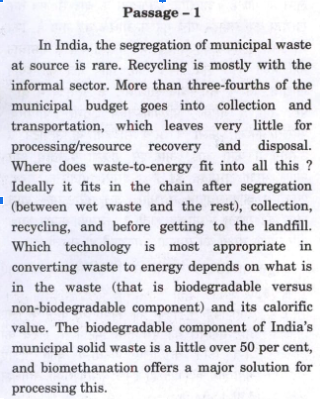UPSC CSAT's APPROACH TO READING COMPREHENSION
Certainly! Succeeding in the UPSC Prelims involves more than just mastering General Studies. The qualifying paper, CSAT, holds significant weight and can determine the fate of your Civil Services aspirations. Within the various sections of CSAT, "Reading Comprehension" presents numerous challenges. However, there are effective strategies available to transform this typically low-scoring section into a high-scoring one. Would you like to explore some of these strategies further?
The CSAT paper, or General Studies Paper-II of the Civil Services (Preliminary) Examination, serves as a qualifying paper with a minimum threshold set at 33 per cent. This 200-mark paper encompasses questions covering various aspects such as comprehension, interpersonal skills including communication, logical reasoning, analytical ability, decision-making, problem-solving, general mental ability, basic numeracy (at Class 10 level), and data interpretation (including charts, graphs, tables, and data sufficiency, also at Class 10 level). These questions are presented in a multiple-choice, objective format.
Distinguishing Assumption from Inference
Assumption: The truth of a given statement relies on the truth of the assumption (B is true only if A is true).
Inference: The truth of an inference depends on whether the given statement provides evidence supporting the inference (C is true only if B is true).
In simplified form, Assumption—Statement—Inference (A—B—C).
Consider the statement: "There is rampant corruption in Panchayati Raj Institutions."
A rational assumption: "Panchayati Raj Institutions exist at the grassroots level of society" (as the prevalence of rampant corruption is contingent upon the existence of Panchayati Raj Institutions).
A rational inference: "Poor services are provided to people living in rural areas" (due to the rampant corruption in the Panchayati Raj Institutions).
Now, let's examine an example passage from the Prelims 2023, which contained two questions—one Assumption type and the other Inference type.
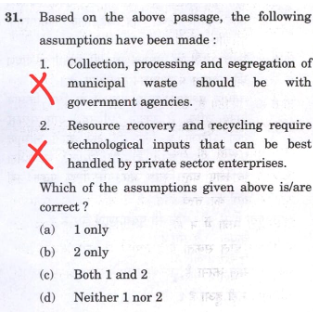
Statement 1: The passage underscores the financial strain municipal bodies face. Therefore, it is not a reasonable assumption from the passage that government agencies are better equipped to manage the collection, processing, and segregation of municipal waste. Hence, Statement 1 is incorrect.
Statement 2: The passage highlights that the private sector, albeit through informally organized units, predominantly manages municipal waste. Additionally, it indicates inefficiencies in the waste management process. Therefore, it is not a logical assumption from the passage that private sector enterprises are the "best suited" for resource recovery and recycling through enhanced technological inputs. Hence, Statement 2 is incorrect.
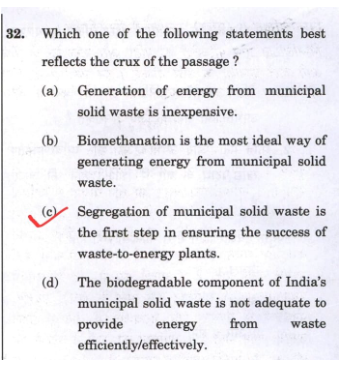
The passage emphasises that the non-segregation of waste is a hindrance to the success of waste-to-energy plants. So, it can be rationally inferred from the passage that “segregation of municipal waste is the first step in ensuring the success of waste-to-energy plants”.
Utilize Common Sense and General Knowledge
While tackling reading comprehension questions, aspirants should employ common sense and general knowledge. It's essential not to confine oneself to the explicit information provided in the passages. Take, for instance, a question from CSAT 2023:
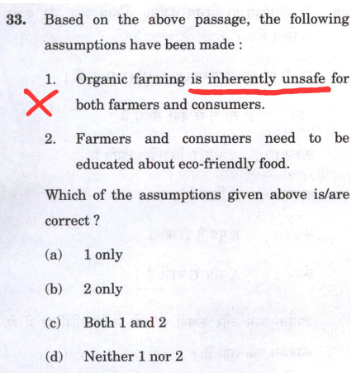
In this scenario, common sense prompts us to question why the government would consistently strive to integrate organic farming with conventional farming methods if organic farming were inherently unsafe.
Avoid Status Quoism and Pessimism
UPSC passages typically do not endorse status quoism or pessimism. If an option appears to advocate for maintaining the status quo or expresses pessimism, it is likely incorrect. For instance, consider this question from CSAT 2023:

The statement "drug-resistant bacteria cannot be done away with" is unlikely to be correct as it carries a pessimistic and status quoist tone.
Avoiding Unnecessary Distractions
UPSC often includes avoidable distractions in CSAT passages, such as elaborations, examples, and data. These elements consume valuable time during the exam without significantly contributing to our understanding of the passage. Consider the example of this passage and associated question from CSAT 2023:
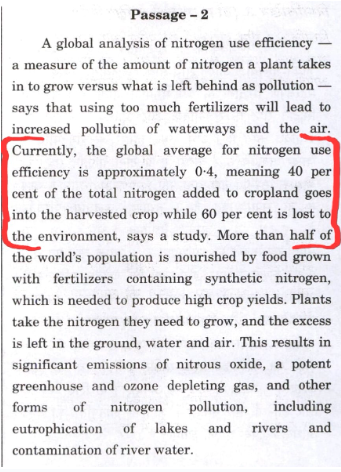

Even if we disregard the elaboration and data provided in the passage, the correct answer can be deduced from the associated question. The passage suggests that both nutritional security and environmental sustainability must be considered when using nitrogenous fertilizers. Therefore, it can be reasonably inferred from the passage that "Enhancing the efficiency of nitrogen use is crucial for both food production and environmental preservation."
Elements of Causality and Intensity
UPSC often formulates incorrect options by incorporating elements of causality, indicating how something causes the assertion to be true. Consider this question from CSAT 2023:

Option (c) provides the reasoning behind why drug-resistant bacteria cannot be eliminated. Statements offering reasons for assertions should be viewed critically.
Furthermore, UPSC utilizes expressions that intensify options, adding undue weight to them. For instance, terms like heavily, totally, entirely, too much, most ideal, etc., amplify options disproportionately. Take, for instance, a question from CSAT 2023:
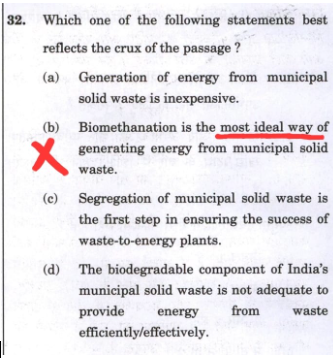
Here, option (b) is more likely to be incorrect due to the intensity conveyed by the phrase "most ideal way of." The word 'ideal' inherently implies superiority. Adding another superlative ('most') artificially heightens the intensity of the option.


